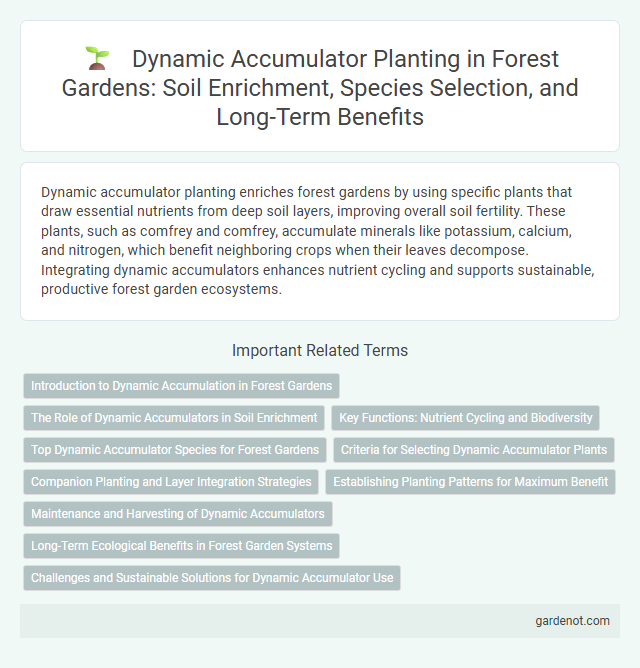Dynamic accumulator planting enriches forest gardens by using specific plants that draw essential nutrients from deep soil layers, improving overall soil fertility. These plants, such as comfrey and comfrey, accumulate minerals like potassium, calcium, and nitrogen, which benefit neighboring crops when their leaves decompose. Integrating dynamic accumulators enhances nutrient cycling and supports sustainable, productive forest garden ecosystems.
Introduction to Dynamic Accumulation in Forest Gardens
Dynamic accumulator planting in forest gardens involves selecting plants that draw up specific nutrients from deep in the soil and store them in their leaves or roots. These plants, such as comfrey, nettle, and dandelion, enhance soil fertility by making essential minerals like potassium, calcium, and phosphorus more accessible to surrounding plants when their biomass decomposes. Integrating dynamic accumulators supports nutrient cycling, improves soil health, and boosts overall forest garden productivity.
The Role of Dynamic Accumulators in Soil Enrichment
Dynamic accumulators play a critical role in soil enrichment by extracting and concentrating essential nutrients from deeper soil layers, making them more accessible to other plants in the forest garden ecosystem. These plants, such as comfrey and dandelion, accumulate minerals like potassium, calcium, and magnesium in their leaves, which, when decomposed, improve soil fertility and structure. Incorporating dynamic accumulators enhances nutrient cycling and supports sustainable, healthy plant growth in permaculture designs.
Key Functions: Nutrient Cycling and Biodiversity
Dynamic accumulator planting enhances nutrient cycling by drawing essential minerals from deep soil layers and concentrating them in surface leaves, which decompose to enrich garden soil naturally. This practice supports biodiversity by attracting diverse beneficial insects and microbes, fostering a balanced ecosystem within the forest garden. Integrating dynamic accumulators promotes soil fertility and resilience, vital for sustainable forest garden productivity.
Top Dynamic Accumulator Species for Forest Gardens
Dynamic accumulator planting enhances soil fertility by using specific plants that concentrate essential nutrients in their tissues. Top dynamic accumulator species for forest gardens include comfrey (Symphytum officinale), which accumulates potassium and calcium; nettle (Urtica dioica), rich in nitrogen and iron; and yarrow (Achillea millefolium), known for drawing up phosphorus and copper. Incorporating these plants in layers effectively recycles nutrients and supports healthy forest garden ecosystems.
Criteria for Selecting Dynamic Accumulator Plants
Dynamic accumulator plants are selected based on their deep root systems, ability to mine specific nutrients, and compatibility with surrounding flora. Essential criteria include nutrient accumulation efficiency, growth rate, and resilience to local climate conditions. Prioritizing species that enhance soil fertility and support biodiversity ensures a thriving forest garden ecosystem.
Companion Planting and Layer Integration Strategies
Dynamic accumulator planting in forest gardens enhances soil fertility by using specific plants that draw up nutrients from deep layers, making them available to companion species through leaf litter and root interactions. Integrating diverse plant layers--from canopy to ground cover--maximizes nutrient cycling and pest control, optimizing growth conditions for all components within the guild. Strategic companion planting promotes symbiotic relationships, ensuring nitrogen fixation, mycorrhizal network support, and efficient resource sharing among trees, shrubs, and herbaceous plants.
Establishing Planting Patterns for Maximum Benefit
Dynamic accumulator planting in forest gardens involves strategically selecting and positioning plants that gather essential nutrients from deep soil layers to enrich the ecosystem. Establishing planting patterns that maximize root zone diversity and nutrient cycling enhances soil fertility and supports neighboring plants' growth. Incorporating species such as comfrey, dandelion, and nettle in clustered arrangements promotes efficient nutrient exchange and sustainable soil health.
Maintenance and Harvesting of Dynamic Accumulators
Dynamic accumulator plants require minimal maintenance, primarily involving regular watering and occasional pruning to encourage healthy growth and nutrient uptake. Harvesting should be timed when leaves or roots are most nutrient-rich, often just before flowering, to maximize the nutrient return to the soil when composted or mulched. Proper care and timely harvesting enhance soil fertility and support the overall productivity of the forest garden ecosystem.
Long-Term Ecological Benefits in Forest Garden Systems
Dynamic accumulator planting enhances soil fertility by mining essential nutrients from deep within the earth and making them available for surrounding plants, promoting sustainable nutrient cycling in forest garden systems. This process enriches soil organic matter and microbial activity, leading to improved soil structure and water retention over time. The long-term ecological benefits include increased biodiversity, reduced need for external fertilizers, and greater resilience of the forest garden ecosystem against environmental stressors.
Challenges and Sustainable Solutions for Dynamic Accumulator Use
Dynamic accumulator planting faces challenges such as identifying the most effective plants for specific soil deficiencies and managing potential nutrient imbalances caused by excessive accumulation. Sustainable solutions include implementing diverse polycultures that target a broad range of nutrients and regularly monitoring soil health to adjust plant selection accordingly. Integrating composting and mulching practices enhances nutrient cycling, supporting the long-term effectiveness of dynamic accumulators in forest garden ecosystems.
Dynamic accumulator planting Infographic

 gardenot.com
gardenot.com